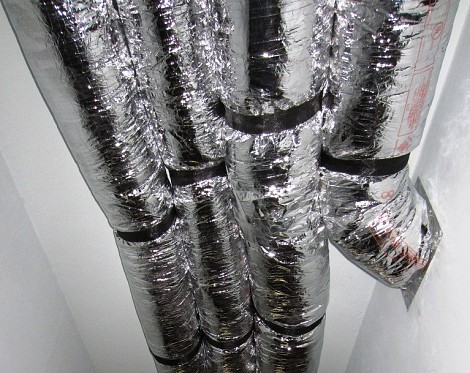The Importance of Having Insulation in Your Ductwork

Ductwork refers to the system of ducts and pipes that circulate heated or cooled air throughout your house. Adding ductwork insulation to this system offers you 3 valuable benefits: lowered utility bills, reduced energy consumption, and a more comfortable home. Learn why you’ll save money and energy with ductwork insulation and how it should be installed.
Why Is Ductwork Insulation Important?
Ductwork insulation ensures that air traveling through the duct system will stay at the desired temperature and won't "leak" out. Leaking air results in unnecessary energy loss, which means that your HVAC system will have to work even harder. This will cause higher utility bills as a result of wasted energy … not good for you or the environment. Without proper ductwork insulation, you could be losing 10-30% of the energy used to heat or cool your home. A good level of ductwork insulation will prevent not only energy wastage, but also leaks, temperature drops, and condensation buildup.
What R-Value is Best?
HVAC contractors recommend that ductwork insulation have an R-value of at least 5, although the highest R-value available, 8, is preferable.
Where Is Ductwork Insulation Most Necessary?
Ducts tend to be made of thin material, usually sheet metal or fiberglass, which is why it is so easy for the air traveling through them to be lost. Proper insulation will ensure that the regulated temperature will be maintained as the air makes its way from the furnace or air conditioner to your living areas. The ductwork in unconditioned areas, such as basements, floors, and ceilings is where ductwork insulation is most necessary.
Ductwork Insulation Prevents Condensation
Cool air passing through warm areas in your home can cause condensation in the ductwork. This condensation leads to moisture buildup inside the enclosed space of the duct system. In turn, the moisture can lead to all sorts of problems, such as mold and mildew growth. Proper insulation levels can actually prevent condensation form occurring in your ductwork.
Seal Ducts Before Insulating
Before adding ductwork insulation, it is highly recommended to first seal leaks in the ductwork. Find an HVAC contractor to seal the ductwork, specifically all of the points in the duct run. The proper way to seal is with a material called mastic that is brushed on and then left to dry for about a day. Mastic is used because it does not deteriorate or shrink away from the joints. Keep in mind that, despite its name, duct tape should not be used for sealing ductwork; it could deteriorate and decompose and cease to be effective to seal the leaks, leaving you with a sticky, useless mess on the ductwork itself.
Types of Ductwork Insulation
The most common ductwork insulation material is fiberglass. A newer and more effective option is duct wrap, such as Reflectix. Here’s a comparison of the 2 materials:
1. Fiberglass insulation
- Cost-effective
- Easy to install
- Easy to replace
- Absorbs noise
- Needs to be inspected often for any moisture absorption
2. Reflectix (duct wrap):
- Very efficient and stable
- Lightweight
- Made up of foil faces on the outside that hold bubble pack between layers of polyethylene
- Has an R-value of 5.6, when installed according to manufacturer's specifications
- No risk of moisture problems as with fiberglass
Updated December 21, 2017.
Looking for a Pro? Call us (866) 441-6648

Heating & cooling Average Costs
HVAC Contractors Experiences

New Ceiling Fans For A New Home

Restaurant Ceiling Fan Installation To Beat The Florida Heat



